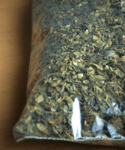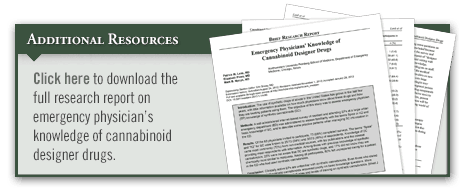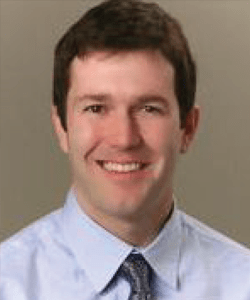Over the last few years, research has shown that abuse of synthetic drugs is becoming more common throughout the country. In response to this, the United States Drug Enforcement Agency has listed an increasing number of synthetic cannabinoids (SC) as Schedule 1 substances, and Congress has passed the Synthetic Drug Abuse Prevention Act. “SC products have received substantial media attention for being sold as legal highs,” explains Patrick M. Lank, MD. Common SCs include “Spice” and “K2,” and these drugs are often packaged as incense.
Tough Spot for EDs
Complications from SC use have led to an increase in hospital visits, particularly for EDs. “The initial growth of SC use in the U.S. was sparked by reports that they had effects similar to marijuana,” says Dr. Lank. “An added advantage was that they were thought to be undetectable on routine urine drug screens and were widely available by legal public consumer means. We have learned over time that the clinical effects of SCs are quite different from those caused by smoking marijuana.” There is growing concern for the potential of long-term immunologic, neurologic, and psychiatric complications with SC use, specifically in adolescents.
Dr. Lank says emergency physicians (EPs) are in a particularly difficult position as the use of new synthetic drugs increases in popularity. “EPs often must treat patients who abuse SCs despite having relatively little knowledge of these substances,” he says. “Considering the increasing popularity of SCs, it’s important to assess EP knowledge of these designer drugs and explore ways to optimize care for patients presenting to EDs after exposure to these drugs.”
New Data & Insights
In the Western Journal of Emergency Medicine, Dr. Lank and colleagues had a study published examining EP knowledge of SCs. The research team reviewed survey responses of ED residents and attending EPs to look at their familiarity with the terms Spice or K2 and their basic knowledge of SCs. Most EPs had never heard of Spice or K2, and few had taken care of a patient who used SCs. Among physicians familiar with SCs, 25% were not aware they are synthetic drugs. When asked about symptoms, 47% would not expect to see anxiety, sedation, or psychosis in patients who used SCs. “Physicians often obtained their information about SCs from sources other than medical publications or lectures,” Dr. Lank says (Figure). Lay publications, patients, colleagues, and the internet were the sources from which respondents most commonly learned about SCs.
“About 80% of participants in our study did not feel prepared to care
for patients in the ED who had used SCs.”
The analysis also showed that physicians who never heard of Spice or K2 were more likely to order additional testing when compared with those who were familiar with SCs. EPs who were unfamiliar with SCs were more likely to admit users to the hospital. “About 80% of participants in our study did not feel prepared to care for patients in the ED who had used SCs,” says Dr. Lank (Table). Another 92% felt they needed more education on emerging drugs of abuse.
A Constant Evolution
The study by Dr. Lank and colleagues highlights the unfamiliarity and inexperience with SCs among EPs. “This is especially problematic considering that use of SCs was rapidly growing in popularity when the survey was performed,” says Dr. Lank. “There are many misconceptions about SCs and their clinical effects. Abusers of SCs will require unique care approaches based on clinical effects and lab abnormalities.”
Conducting designer drug investigations is particularly difficult in EDs because of constantly changing aspects in the development and use of designer drugs. “This evolution makes it hard to keep up with the knowledge of SCs,” Dr. Lank says. “It’s also concerning that most physicians obtain their information on SCs from non-medical sources. The medical literature currently available is constantly changing, with reports of novel side effects and complications. Our study brings to light the challenges physicians face when treating these patients.”
One strategy that might help overcome knowledge gaps on SC use involves the role of medical toxicologists on staff. Few hospitals employ these specialists full time, but they can be of great service by educating other healthcare providers on new developments in toxicology. “Most hospitals without a medical toxi-cologist on staff may instead rely on information provided by their regional poison center,” Dr. Lank says. “With the limitless number of designer drug compounds that are available and with little information on the
toxicity of each compound, it’s important to make a connection between toxicologists, poison centers, and other experts in emerging drugs of abuse to ensure that EPs are better prepared to manage these patients.”




 admin
admin